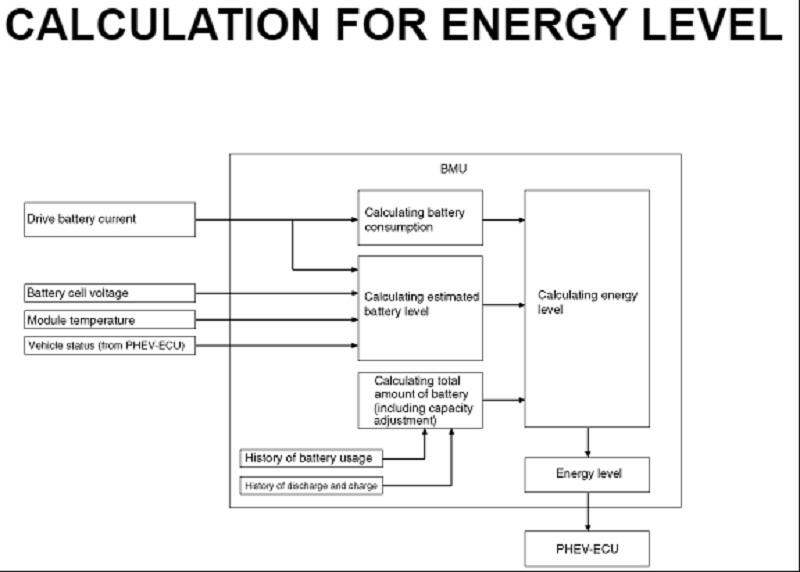Trex said:
This is from the same website as above but from their Technical information manual.

Please note the Calculating total amount of battery (including capacity adjustment) using History of battery usage and History of discharge and charge
on the bottom left of the BMU.
Thanks for the picture Trex
This is exactly what I did observed
There are only 2 way for calculate the capacity into a Lithium battery:
1) - By known the capacity at state A, and knowing how much current have been extracted (oor added) from the battery in the time between state A and B .. so the capacity of the state B can be computed = Capacity B = Capacity A - Consumed Current
2) - Having a table between Voltage and Capacity, knowing the voltage level of the Lithium battery allow to know the capacity ... if the battery is left unused for at least 2 hours for get stabilized from eventual voltage drop from the "heavy" usage
So .. this is what our PHEV is doing.
- Our PHEV believes it has a SOH set to value X .. from factory is 38Ah (let assume this value for clarify the scenario)
- Let assume the battery is fully charged ...then the PHEV know there are 38Ah usable from the battery -> 38Ah = SOC
- While the PHEV is under usage, the PHEV ECU (or BMU ecu) monitor all the time the current in and out (this monitoring can have computations and measuring errors, but that's a "detail" for now)
- Let assume 10Ah as been consumed in the trip, and then the car is parked unused for 3h. End voltage let say is 3.80v per cell.
- Just after the trip the car believe it has 28Ah capacity left, only based on the original capacity - consumed current .. voltage is not relevant when car is used, since is much lower then expected due to the "stress" of usage.
- After 3h we switch on the car .. the Voltage per cell is now up to 3.90V
- Now the ECU will compute and correct the SOC ... SOC is now based on the Voltage .. let say 3.90V per the ECU PHEV table is equal to 70% SOC ... so the ECU will consider as new SOC Capacity = % * SOH -> 70% * 38Ah = 26.6Ah
- 26.6Ah is now consider as base for EV range estimation (together with the last trip consumption history)
- The PHEV notice and register a "missing" capacity ... 26.6Ah vs 28Ah ... so 1.4Ah deficit .. this is consider as error
- The PHEV store all the errors and on monthly (or every X days) base or based on error level threshold (which will arrive first) .. all the error are added together .. and if the ECU detect that in average the error was negative for X Ah ... it will change the Ah SOH accordingly .. it can be reduced by 0.5 if the error accumulated is high .. or only 0.1Ah if the error was low ... but as well SOH .. can be increase if the PHEV detect the error was "positive"
This explain why somebody notice the missing capacity in the PHEv after 2h or more of resting
This explain how the SOH is changing in our PHEV
Assuming the monitor of the current is correct .. and assuming the voltage-capacity in % mapping table .. it is correct .. the system above is perfectly fine for monitoring the degradation of the battery without the need to fully charge and discharge the battery, something that is is not really possible and as well it will age faster the battery too
With the MUT / or wrong Smoothing procedure people can reset to 38Ah the SOH ... but the system in place slowly will detect the error of the assumed SOH and it will be "corrected" automatically by the car ... still .. while the correction is happening, people can enjoy longer EV range, since simply the battery can be discharged more then what Mitsubishi did originally design





























